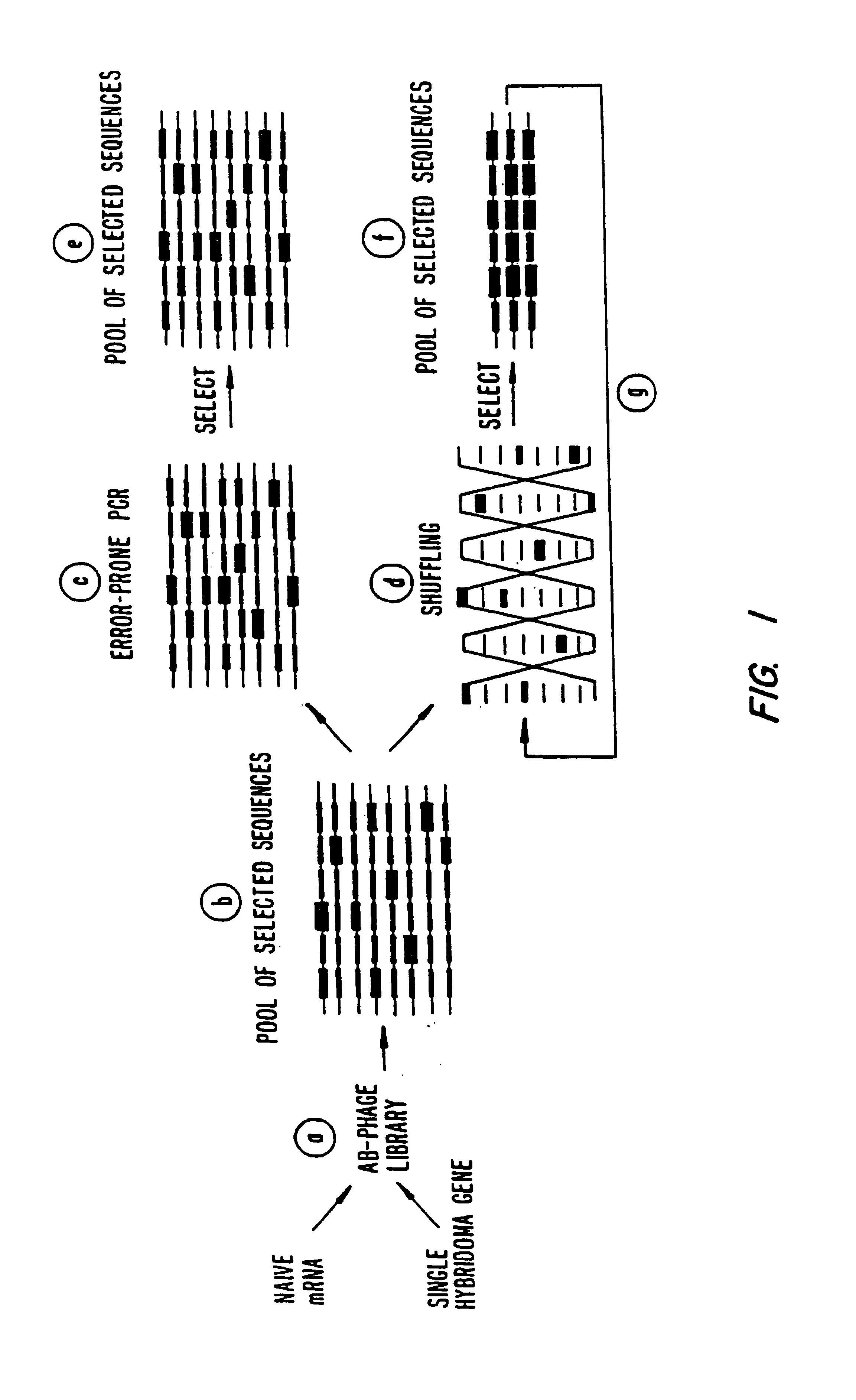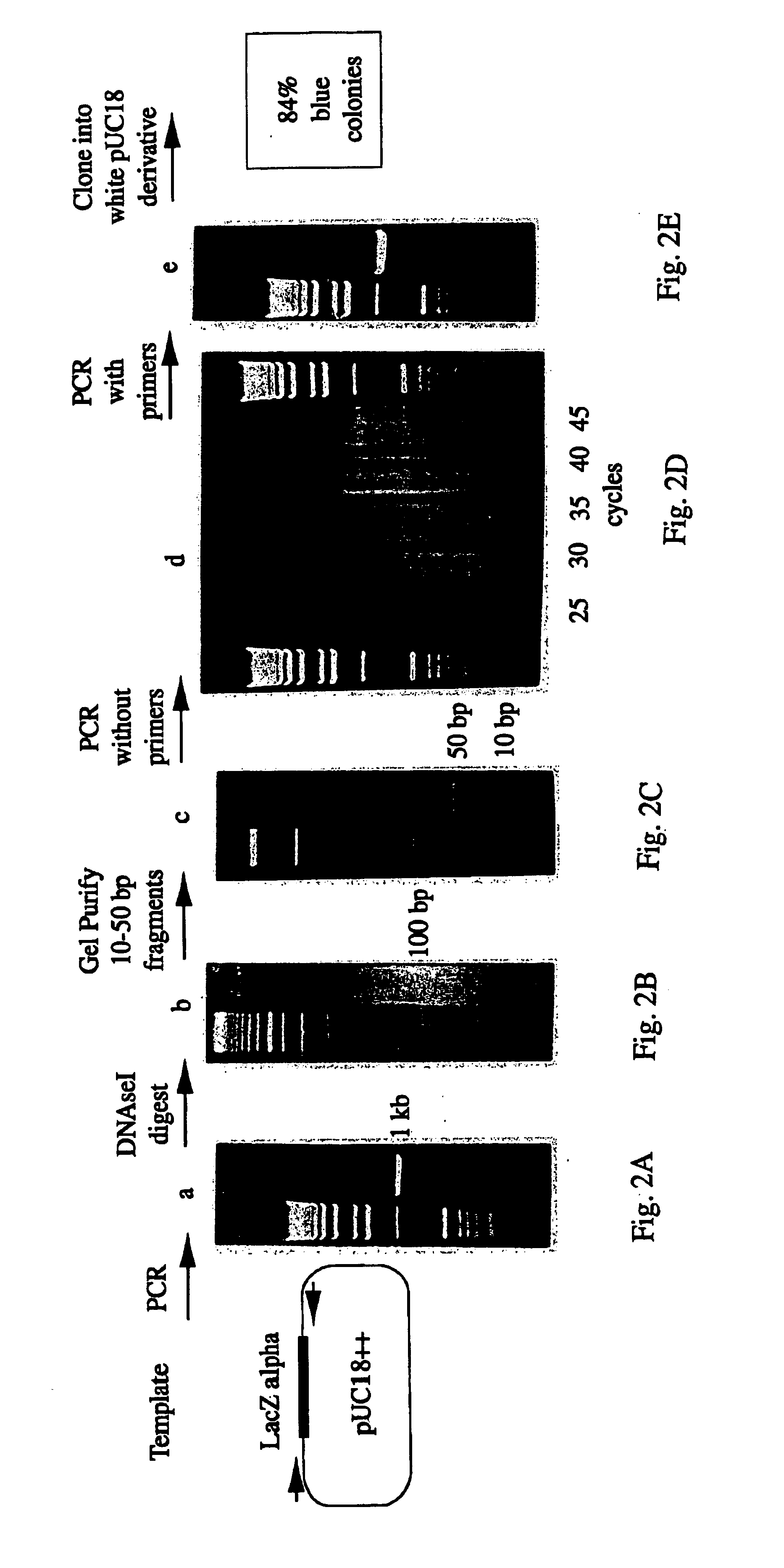Methods for generating polynucleotides having desired characteristics by iterative selection and recombination
a polynucleotide and iterative selection technology, applied in the field of iterative selection and recombination methods for generating polynucleotides having desired characteristics, can solve the problems of limiting the practical application of the approach, limiting the number of blocks, and limiting the number of combinations of distant mutations, so as to enhance the rate of recombination, and enhance the frequency of mutations
- Summary
- Abstract
- Description
- Claims
- Application Information
AI Technical Summary
Benefits of technology
Problems solved by technology
Method used
Image
Examples
experimental examples
[0360]In the examples below, the following abbreviations have the following meanings. If not defined below, then the abbreviations have their art recognized meanings.[0361]ml=milliliter[0362]μl=microliters[0363]μM=micromolar[0364]nM=nanomolar[0365]PBS=phosphate buffered saline[0366]ng=nanograms[0367]μg=micrograms[0368]IPTG=isopropylthio-β-D-galactoside[0369]bp=basepairs[0370]kb=kilobasepairs[0371]dNTP=deoxynucleoside triphosphates[0372]PCR=polymerase chain reaction[0373]X-gal=5-bromo-4-chloro-3-indolyl-β-D-galactoside[0374]DNAseI=deoxyribonuclease[0375]PBS=phosphate buffered saline[0376]CDR complementarity determining regions[0377]MIC minimum inhibitory concentration[0378]scFv=single-chain Fv fragment of an antibody
[0379]In general, standard techniques of recombination DNA technology are described in various publications, e.g. Sambrook et al., 1989, Molecular Cloning: A Laboratory Manual, Cold Spring Harbor Laboratory; Ausubel et al., 1987, Current Protocols in Molecular Biology, vo...
example 1
LacZ Alpha Gene Reassembly
1) Substrate Preparation
[0380]The substrate for the reassembly reaction was the dsDNA polymerase chain reaction (“PCR”) product of the wild-type LacZ alpha gene from pUC18. (FIG. 2) (28; Gene Bank No. XO2514) The primer sequences were 5′AAAGCGTCGATTTTTGTGAT3′ (SEQ ID NO:1) and 5′ATGGGGTTCCGCGCACATTT3′ (SEQ ID NO:2). The free primers were removed from the PCR product by Wizard PCR prep (Promega, Madison Wis.) according to the manufacturer's directions. The removal of the free primers was found to be important.
2) DNAseI Digestion
[0381]About 5 μg of the DNA substrate was digested with 0.15 units of DNAseI (Sigma, St. Louis Mo.) in 100 μl of [50 mM Tris-HCl pH 7.4, 1 mM MgCl2], for 10-20 minutes at room temperature. The digested DNA was run on a 2% low melting point agarose gel. Fragments of 10-70 basepairs (bp) were purified from the 2% low melting point agarose gels by electrophoresis onto DE81 ion exchange paper (Whatman, Hillsborough Oreg.). The DNA fragmen...
example 2
LacZ Gene and Whole plasmid DNA Shuffling
[0394]Crossover between two markers separated by 75 bases was measured using two LacZ gene constructs. Stop codons were inserted in two separate areas of the LacZ alpha gene to serve as negative markers. Each marker is a 25 bp non-homologous sequence with four stop codons, of which two are in the LacZ gene reading frame. The 25 bp non-homologous sequence is indicated in FIG. 3 by a large box. The stop codons are either boxed or underlined. A 1:1 mixture of the two 1.0 kb LacZ templates containing the +− and −+ versions of the LacZ alpha gene (FIG. 3) was digested with DNAseI and 100-200 bp fragments were purified as described in Example 1. The shuffling program was conducted under conditions similar to those described for reassembly in Example 1 except 0.5 μl of polymerase was added and the total volume was 100 μl.
[0395]After cloning, the number of blue colonies obtained was 24%; (N=386) which is close to the theoretical...
PUM
| Property | Measurement | Unit |
|---|---|---|
| temperature | aaaaa | aaaaa |
| temperature | aaaaa | aaaaa |
| temperature | aaaaa | aaaaa |
Abstract
Description
Claims
Application Information
 Login to View More
Login to View More - R&D
- Intellectual Property
- Life Sciences
- Materials
- Tech Scout
- Unparalleled Data Quality
- Higher Quality Content
- 60% Fewer Hallucinations
Browse by: Latest US Patents, China's latest patents, Technical Efficacy Thesaurus, Application Domain, Technology Topic, Popular Technical Reports.
© 2025 PatSnap. All rights reserved.Legal|Privacy policy|Modern Slavery Act Transparency Statement|Sitemap|About US| Contact US: help@patsnap.com



